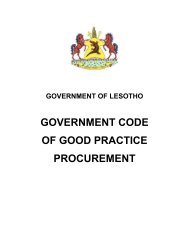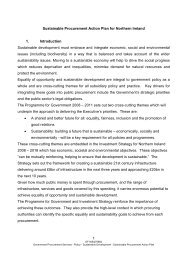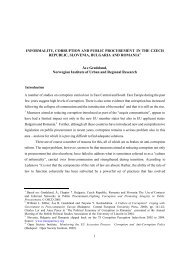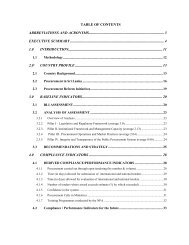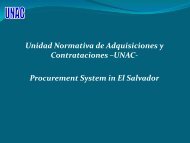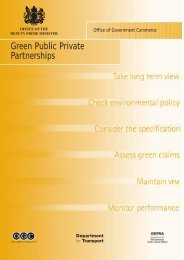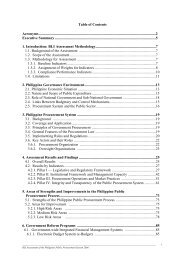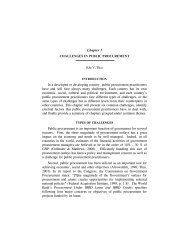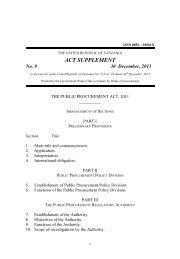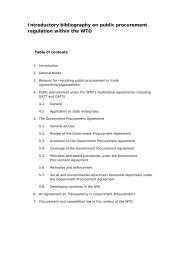Compendium of Country Examples and Lessons Learned from ...
Compendium of Country Examples and Lessons Learned from ...
Compendium of Country Examples and Lessons Learned from ...
Create successful ePaper yourself
Turn your PDF publications into a flip-book with our unique Google optimized e-Paper software.
<strong>Country</strong> experiencesMost <strong>of</strong> the pilot countries started with the Baseline Indicators <strong>and</strong> have begun to measure the CPIs asa second step. Application <strong>of</strong> the Methodology has indicated that both parts are needed to fully assessa national procurement system.Methods to arrive at the “right score”Pilot countries have emphasised that when conducting the BLI assessment, discussions ultimatelyfocused on the scoring. Sometimes members <strong>of</strong> the assessment team did not have the same amount <strong>of</strong>information <strong>and</strong> consequently they arrived at different conclusions. In some cases, donors or otherstakeholders questioned the evidence or reliability <strong>of</strong> data in order to arrive at an agreement on thescoring based on evidence. The following country examples illustrate a number <strong>of</strong> approaches appliedto arrive at the “right score”. The examples can be grouped in three scenarios:Scenario 1 Pure self-assessmentScenario 2 Self-assessment with second independent scoringScenario 3 Joint government/donor assessmentScenario 1: Pure self-assessmentIn a “pure” self-assessment, the government itself - without involving development partners or otherstakeholders - does the scoring.Afghanistan <strong>and</strong> Sierra Leone, both post-conflict countries presently in a transition phase between theold procurement regime to a new national procurement system, have carried out self-assessments. TheWorld Bank supported the assessment in Afghanistan, <strong>and</strong> no other stakeholders were included in thescoring or validation process. Sierra Leone has reported that the interest <strong>and</strong> participation <strong>of</strong>development partners has been „minimal‟ so far, although they have been invited to participate.Yemen, a non-pilot country, conducted a self-assessment focusing on four key ministries.Scenario 2: Self-assessment with second independent scoringA few countries such as Botswana, Mongolia, Ug<strong>and</strong>a, Vietnam, Niger <strong>and</strong> Zambia have chosen atwo-step approach. Typically, one scoring was undertaken by the assessment team (self-assessment), asecond independent scoring was provided either by an external assessor or a group <strong>of</strong> stakeholders.Then, the assessment results were discussed in a workshop <strong>and</strong> usually consolidated by determiningthe average score for each sub-indicator.In Botswana, a comparative analysis was part <strong>of</strong> the scoring process. It was agreed during thevalidation workshop that the report should keep the two results separate (those <strong>from</strong> the workshop <strong>and</strong>those <strong>from</strong> AfDB public procurement team) so as to compare them <strong>and</strong> draw conclusions <strong>from</strong> thetwo. In Vietnam, the initial scoring <strong>of</strong> the pilot assessment was done by an external assessor <strong>and</strong> thencompared with a second scoring done by 13 staff members <strong>of</strong> the Department <strong>of</strong> Public Procurement.COMPENDIUM OF COUNTRY EXAMPLES AND LESSONS LEARNED […] - OECD 2008 27



